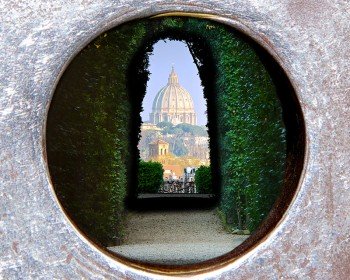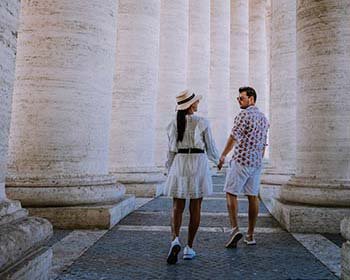If you are in Rome for the first time and you want to explore its city centre in a more original way follow the majestic monuments and Churches chosen by writer Dan Brown to be featured in its book “Angels and Demons”. Read our article and find out the main Angels and Demons places in Rome.
- Pantheon
You can start your walk in Rome from one of the most ancient and best preserved monuments, the Pantheon. It used to be a pagan temple (its name comes from the Greek for “To All Gods”), but it was later turned into a Catholic Church, which today hosts the tombs of many artists and important characters. Italian Kings Umberto I and Vittorio Emanuele II, Queen Margherita, even Italian artist Raphael is buried in the Pantheon. Professor Robert Langdon, the famous main character in the book “Angels and Demons”, makes a mistake in translating one of the clues to solve the mistery and ends up to the Pantheon, instead of the Church of Santa Maria del Popolo. To reach the Pantheon by public transport take bus number 40 from Termini station and get off at Largo Argentina. The round building is just within walking distance. - Santa Maria del Popolo
Once you have finished your visit to the Pantheon you can walk to reach the main shopping street, Via del Corso, to reach Piazza del Popolo. Here there are two famous twin churches, and an obelisk with fountains and lions, but the place chosen by Dan Brown for Robert Langdon is the Church of Santa Maria del Popolo. Beautiful works by painters Pinturicchio and Raphael are hosted here, but what was important for Robert Langdon was the Chigi chapel. Here he found the dead body of a cardinal, branded with the word “EARTH” on the chest.
- The Vatican
To reach the next step of this Roman walk you can simply take the line A of the subway from FLAMINIO and get off at OTTAVIANO/SAN PIETRO. You will be amazed by the stunning St. Peter’s Basilica, the centre of Christianity, surrounded by the magnificent Bernini’s colonnade. At the centre of the square lies an obelisk, surrounded by a sundial with a compass rose built with beautiful oval tiles. The most famous among these ovals is the “WEST”: here Professor Langdon finds another dead cardinal, whose lungs had been punctured and branded with the word “AIR”. Whilst in the Vatican City Langdon also enters the Vatican archives, to browse books and documents and find more about the sect of the “Illuminati”. - Santa Maria della Vittoria
After leaving the Vatican you can walk through Rome’s main streets (Corso Vittorio Emanuele II, via del Corso, Via del Tritone, Via Barberini) and reach a beautiful Baroque Church, Santa Maria della Vittoria, not far from Trevi Fountain. Inside this Church you will be able to admire of Bernini’s best sculptures, “The Ecstasy of Saint Theresa”. It is an uncompared statue, sculpted with vivid realism, to catch the exact time when the saint was transfixed by an angel and saw the beauty of God. This is yet another of the Angels and Demons places in Rome: Here Robert Langdon finds another cardinal, whose chest had been branded with the word “FIRE”.
- Fountain of the Four Rivers
Other important streets of the Eternal City divides this Church from Navona Square, one of the most beautiful in Rome. It is adorned by three Baroque fountains and the Church of Saint Agnese in Agone, a Baroque masterpiece by Borromini. The three fountains placed in this rectangular square are called “Fountain of the Moro”, “Fountain of Neptune” and “Fountain of the Four Rivers”. This latter was the one chosen by Dan Brown to set the death of yet another Cardinal, whose body was branded with the word “WATER”: the water symbolized by the fountain and the Statues of the Gods of the Four main rivers: Nile, Ganges, Danube and the Rio de la Plata.
- Castel Sant’Angelo
Your Angel and Demons walking tour will end in Castel Sant’Angelo: you can easily reach there from Navona Square, walking on Corso Vittorio Emanuele II and crossing the Saint Angel’s Bridge. The Hadrian’s Mausoleum, the former name of Castel Sant’Angelo, served different purposes during its long life. Built as a burial place for Ancient Rome’s Emperor Hadrian, it was later converted in a prison and a hiding place for the Popes, which they could easily reach from St. Peter’s through a tunnel called “Passetto del Borgo”. Langdon himself runs through this underground passage to stop the attack to the Vatican.
It is interesting to note that all the places we described above features obelisks, Bernini’s works of art and statues depicting Angels: their weapons and hands indicate places which form a cross in Rome, with Castel sant’Angelo in its exact centre. This very monument is the final point of Langdon’s itinerary: in front of the castle we can see the statue of an angel indicating a point in the ground, as if indicating the redention of the “Illuminati” has been completed.







